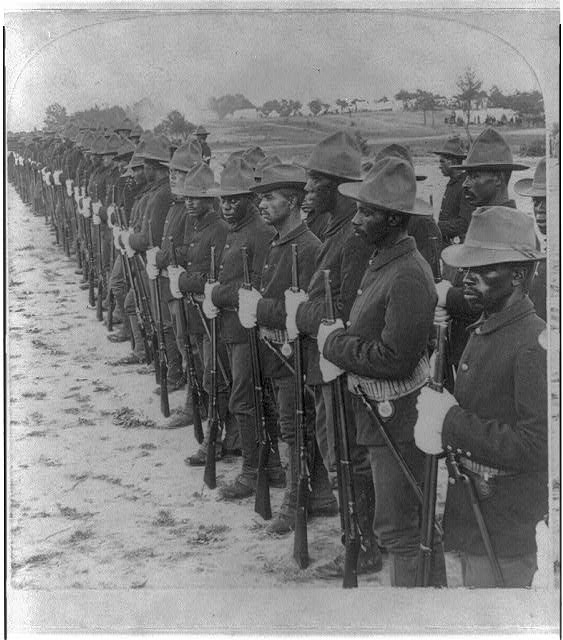Buffalo Soldiers: Ninth and Tenth Cavalry
By Sofie Barrett
The Ninth and Tenth Cavalry formed two African American cavalry regiments commissioned by an act of Congress on July 28, 1866 as part of the US Regular Army. Until the Spanish-American War, these units served in the frontier of the American West in campaigns against Native Americans. Nicknamed the “Buffalo Soldiers,” one common story about the origin of their nickname centers around Native Americans believing the hair of these black troops resembled buffaloes. Another explanation refers to the resiliency of these troops like a cornered buffalo, who despite being wounded, continued to fight. These units embraced the nickname with the Tenth Cavalry even incorporating the buffalo into its crest.
The Army organized the Ninth Cavalry in 1866 in Greenville, Louisiana under Colonel Edward Hatch. By March 1867, the unit totaled 885 enlisted men and spent three months in San Antonio, Texas, training. Later, the Ninth patrolled the western and southwestern regions of Texas and New Mexico. While in Texas, soldiers battled the Apaches, Kiowas, and Comanches, escorted mail, and rescued civilians from Native American attacks. While in New Mexico, their duties included constructing barracks and stables, caring for the horse herds, scouting for Native Americans, escorting the mail, surveying uncharted land, and constructing roads. The unit served under the motto “We Can, We Will.” Twelve men of the Ninth Cavalry received the Medal of Honor, the nation’s highest decoration for valor for their service in the Indian Wars and on the Western Frontier.
The Army organized the Tenth Cavalry in 1866 at Fort Leavenworth, Kansas. However, the unit moved to Fort Riley, Kansas, due to the growing racial tension between black and white troops and the prejudice of the fort commander’s General William Hoffman, who objected to having black troops stationed at Fort Leavenworth. Despite this prejudice, Colonel Benjamin Grierson, the commander of the Tenth, placed high standards for his men. By the end of July 1867, eight companies joined the regiment and served in the Great Plains and the Southwest. The unit served under the motto “Ready and Forward.” Eight men of the Tenth Cavalry received the Medal of Honor for their service in the Indian Wars and the Spanish-American War.
The Ninth and Tenth Cavalry would continue to serve during the Philippine Insurrection, Mexican Punitive Expedition, World War I, and World War II before being deactivated in 1944.
References:
“African Americans in the Frontier Army.” National Park Service. February 24, 2015. Accessed August 20, 2019. https://www.nps.gov/foda/learn/historyculture/africanamericansinthefrontierarmy.htm.
Leckie, William H. and Shirley A. Leckie. Buffalo Soldiers A Narrative of the Black Cavalry in the West. Norman, OK: University of Oklahoma Press, 2014.
Sutherland, Jonathan D. African Americans At War: An Encyclopedia, Vol 1. Santa Barbara, CA: ABC-Clio, 2004.
Tikkanen, Amy. "Buffalo Soldier.” Encyclopedia Britannica. Accessed July 29, 2019. https://www.britannica.com/topic/buffalo-soldiers.
“Who are The Buffalo Soldiers.” Buffalo Soldiers National Museum. Accessed July 29, 2019, http://buffalosoldiermuseum.com/who-are-the-buffalo-soldiers/.
© 2019, University of Central Florida



